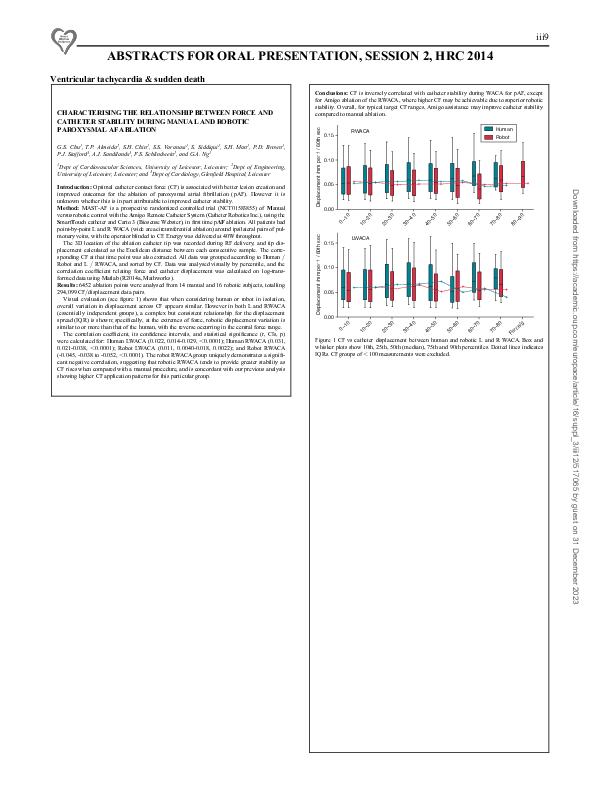Academia.edu no longer supports Internet Explorer.
To browse Academia.edu and the wider internet faster and more securely, please take a few seconds to upgrade your browser.
29Characterising the relationship between force and catheter stability during manual and robotic paroxysmal AF ablation
29Characterising the relationship between force and catheter stability during manual and robotic paroxysmal AF ablation
2014, Europace
Related Papers
Revista Brasileira de Cirurgia Cardiovascular
Emprego de sistemas robóticos na cirurgia cardiovascular2004 •
Pacing and Clinical Electrophysiology
Comparison of Robotic and Manual Persistent AF Ablation Using Catheter Contact Force Sensing: An International Multicenter Registry Study2014 •
Pacing and Clinical Electrophysiology Pace
Improved Electrogram Attenuation during Ablation of Paroxysmal Atrial Fibrillation with the Hansen Robotic System2012 •
Mechatronics in Action: Case Studies in Mechatronics-Applications and Education, pp: 157, 2010
Force Sensing in Medical RoboticsInnovations: Technology and Techniques in Cardiothoracic and Vascular Surgery
Evaluating the Effect of Three-Dimensional Visualization on Force Application and Performance Time During Robotics-Assisted Mitral Valve Repair2013 •
Objective The purpose of this study was to determine the effect of three-dimensional (3D) binocular, stereoscopic, and two-dimensional (2D) monocular visualization on robotics-assisted mitral valve annuloplasty versus conventional techniques in an ex vivo animal model. In addition, we sought to determine whether these effects were consistent between novices and experts in robotics-assisted cardiac surgery. Methods A cardiac surgery test-bed was constructed to measure forces applied during mitral valve annuloplasty. Sutures were passed through the porcine mitral valve annulus by the participants with different levels of experience in robotics-assisted surgery and tied in place using both robotics-assisted and conventional surgery techniques. Results The mean time for both the experts and the novices using 3D visualization was significantly less than that required using 2D vision (P < 0.001). However, there was no significant difference in the maximum force applied by the novices t...
Methods of Information in Medicine
Quantitative Evaluation of Performance during Robot-assisted Treatment2016 •
The inherent dynamics of the master manipulator of a teleoperated robot-assisted surgery (RAS) system can affect the movements of a human operator, in comparison with free-space movements. To measure the effects of these dynamics on operators with differing levels of surgical expertise, a da Vinci Si system was instrumented with a custom surgeon grip fixture and magnetic pose trackers. We compared users' performance of canonical motor control movements during teleoperation with the manipulator and freehand cursor control, and found significant differences in several aspects of motion, including target acquisition error, movement speed, and acceleration. In addition, there was preliminary evidence for differences between experts and novices. These findings could impact robot design, control, and training methods for RAS.
2015 •
RELATED PAPERS
International Journal of Veterinary Science and Research
Examination of urine2018 •
Contemporary Italian Politics
Bubble Democracy. La fine del pubblico e la nuova polarizzazione2020 •
Public Health Nutrition
Vegetarian diet and cholesterol and TAG levels by gender2014 •
2021 •
2007 •
Journal of Mathematics Teacher Education
Using concept maps to assess change in teachers’ understandings of algebra: a respectful approach2007 •
Sewa Ruang Seminar Murah Di Jakarta di Pamulang
REKOMENDASI, WA 0851-7983-5498, Sewa Ruang Seminar Murah Di Jakarta di PamulangThe Journal of Physical Chemistry A
Nonadiabatic Electron Transfer: Exact Analytical Expression of through-Conjugated-Bridge Effective Coupling and Its Asymptotics and Zeros1998 •
Nature Communications
Skeletal Ni electrode-catalyzed C-O cleavage of diaryl ethers entails direct elimination via benzyne intermediates2022 •
Hospital Pharmacology
Analysis of the relevance of antibiotic therapy and the experience of prescribers in the pediatric department at Bouaké University Hospital (Côte d'Ivoire)2024 •
2017 •
BMJ (Clinical research ed.)
Identifying and managing common childhood language and speech impairments2015 •
RELATED TOPICS
- Find new research papers in:
- Physics
- Chemistry
- Biology
- Health Sciences
- Ecology
- Earth Sciences
- Cognitive Science
- Mathematics
- Computer Science

 Fernando Schlindwein
Fernando Schlindwein